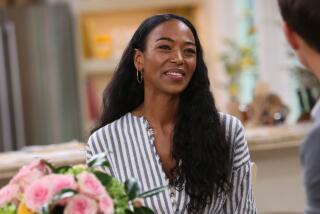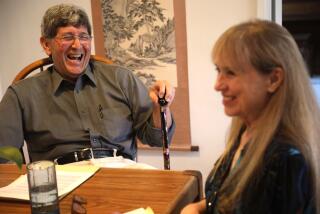A Ritual That Made Illness Bearable
No one remembers for sure who started the pass-the-teddy-bear ritual.
The messages pinned to its collar were typically short and to the point: “I did it. You will, too.” The heartfelt words often meant the difference between giving up or hanging on.
Back and forth the bear traveled among seven patients, ages 16 to 49, who had entered the bone marrow transplant unit at the City of Hope National Medical Center in Duarte. Why these seven, who took up just a small part of the 39-bed BMT unit, formed such a special bond, is a mystery even now, even to them.
For nearly a year--starting in 1991--they were often hospitalized at the same time either during BMT or when they returned for follow-up.
In the beginning, they shared only their dire diagnoses--leukemia, lymphoma or other life-threatening cancers--and their need for a bone marrow transplant.
Then they faced together the promise and the horror of BMT. When used to treat malignant disease, BMT first involves high doses of chemotherapy or radiation therapy to kill the cancer cells, and in the process destroying the bone marrow. Then, stem cells from healthy marrow--which produces the body’s blood cells--is taken from a genetically matched donor and infused. Afterward, a 21-day isolation period is common. Then come the risks of rejection, pneumonia and other setbacks.
Hardly easy to keep up one’s spirits in this environment. But sometime after the teddy bear ritual began, someone broached the subject: Why not plan a huge celebration in five years?
To a cancer patient, surviving five years is a milestone. In the first year after the transplant, BMT patients with unrelated donors are given only a 15% chance of survival. Five years after BMT, the survival rate can soar to 95%.
“Five years is very special,” says Dr. Pablo Parker, a hematologist-oncologist at City of Hope.
The seven made it past the critical first 100 days.
Then the first year.
At informal reunions held twice a year, they talked more about the five-year party.
Then, as the last of the five-year “birthdays” approached, out went the party invitations to donors, significant others, family, doctors, nurses, friends and neighbors.
The patients titled the gala “Five Years to Life,” but what really told the story was the subtitle: “A Celebration of Seven Lives Rescued from Cancer.”
In all, more than 400 people came to celebrate, schmooze, drink, eat dinner and dance in the ballroom of the Doubletree Hotel in Pasadena last weekend.
For the seven--some still return for follow-up care--it was a chance to express their thanks. One by one, they stepped up to the balloon-festooned podium.
* “Wow!” grinned Dale Denio, 49, of Bakersfield, who at age 42 was found to have chronic myelogenous leukemia. “I’m really happy to be here. I think I’m the happiest. We are all not sure who’s the most thankful, that’s the hard part.” Little did he dream, five years ago, that he would by now have expanded his equipment rental business and be getting teased for arriving at his follow-up appointments in a helicopter.
* Dawn Miller, 29, of Susanville, Calif., told of learning at age 23 that she had acute myelogenous leukemia and some of the changes that followed. Her longtime boyfriend pledged to stand by her always, then disappeared. But Miller pulled through it all just fine. “I have a new guy in my life now,” she said proudly. She glanced his way into the audience. “Thanks, Albert.”
* Matthew Phelan, 36, of Northridge, had a successful computer programming business when his illness was diagnosed as advanced lymphoma in 1992. Phelan, who is on his way to becoming a math teacher, alerted the audience to the peril of being a male with a female marrow donor: incessant teasing. When Phelan visits the Duarte medical center, where his story is well-known, he often hears, “Hey, Matt, how are you handling the PMS?”
Nodding to his donor Cindi Lynch, who had flown in from New Jersey for the event, he said, “I have the most beautiful donor in the world.”
* Michael Nelson took the audience back in time to his 16th year, when he fulfilled his dream of qualifying for the varsity football team at Temple City High School--and soon after was found to have acute lymphocytic leukemia. Of his treatments, he said: “I lost my hair and most of my energy, but I made a lot of new friends.” His sister Jennifer, 24, sitting in the audience, turned out to be his perfect donor match, although she was anxious about the testing because of her fear of needles. As soon as the lab tech felt her arm, teased Michael, now 21, “she began to cry.” Then, as Michael thanked Jennifer for giving him “a second chance at life,” so did he.
* Vince Ballardo promised to be brief. Earlier in the day, he had renewed his wedding vows with his wife of 10 years, Christy, in front of their 8-year-old son, Blake, other family and friends. “I cried so much today, I am getting dehydrated,” said Ballardo, 40, of Carlsbad, who was running a printing business when he learned he had leukemia. (He’s now a stay-at-home dad.) “Did any of the nurses bring an IV?”
* Mary Martinez, 36, of Temecula, recalled the day she headed to the BMT unit. It was six months after her husband had died of Hodgkin’s disease. While caring for him, she found out she had chronic myelogenous leukemia. “The hardest thing was standing in the driveway of my home and saying goodbye to my boys, not knowing if I’d ever see them again.
“Tonight, I have the privilege of introducing two of the greatest guys in the world--my sons Michael and Delfino Jr. Stand up, guys.”
* Fernando Castillo of Moreno Valley, 55, spent his 50th birthday and 25th wedding anniversary in the unit, after he learned he had chronic myelogenous leukemia. The most outwardly religious of the seven, he opened his talk with a prayer, but his playful side soon appeared. Holding up a T-shirt with Conan the Barbarian’s body and his face, the slightly built Castillo said: “Here’s what I looked like before the transplant.”
By the way, Castillo now has custody of the bear. It was handed over to him to see him through a bout of bronchitis. He’s ready to pass it on to the next person who needs it--and hoping no one will.
More to Read
Sign up for Essential California
The most important California stories and recommendations in your inbox every morning.
You may occasionally receive promotional content from the Los Angeles Times.










